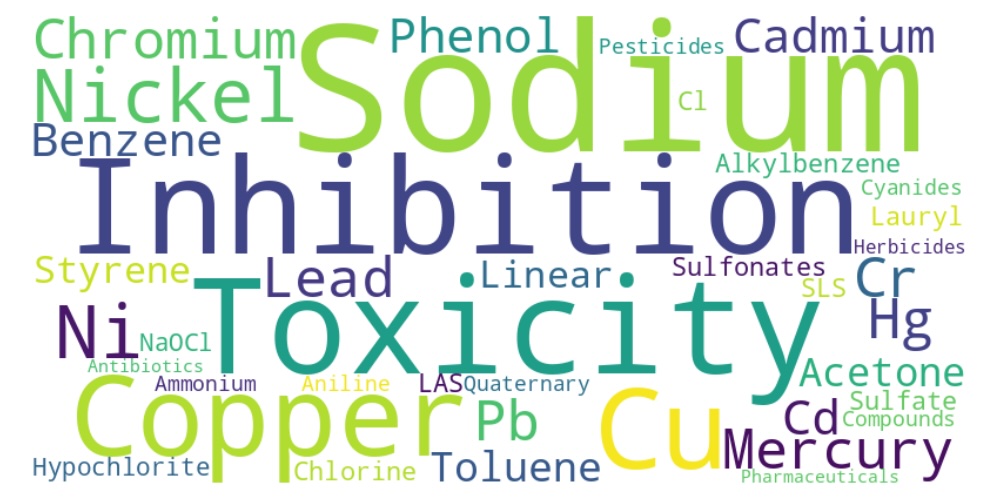
We are often asked about the impact of various chemicals on wastewater treatment plants. Over the years, we have compounded a list of the primary industrial chemicals that inhibit the growth and activity of microorganisms in wastewater treatment systems, leading to a loss of treatment efficiency (especially in biological processes like activated sludge), fall into several main categories:
Primary Inhibitory Industrial Chemicals
| Category | Examples of Chemicals/Compounds | Key Impact on Microorganisms |
| Heavy Metals | Copper (Cu), Nickel (Ni), Chromium (Cr), Lead (Pb), Mercury (Hg), Cadmium (Cd) | Highly toxic, they denature enzymes and disrupt cellular processes even at low concentrations, particularly affecting nitrifying bacteria (which are critical for nitrogen removal). Also tend to bioaccumulate in biofilms/floc. |
| Organic Solvents/Volatile Organic Compounds (VOCs) | Phenol, Benzene, Toluene, Acetone, certain alcohols and esters (e.g., Ethyl Acetate, Butyl Acetate), Styrene | Can be directly toxic to the microbial cell membrane and metabolic processes. They often originate from chemical manufacturing, solvent use, or petrochemical industries. |
| Surface Active Agents (Surfactants/Detergents) | Linear Alkylbenzene Sulfonates (LAS), Sodium Lauryl Sulfate (SLS) | Used widely in cleaners and industrial processes. They can emulsify fats, oils, and grease (FOG), making them harder to remove in primary treatment, and at high concentrations, they can inhibit biological activity and interfere with oxygen transfer. |
| Biocides/Disinfectants | Chlorine (Cl), Sodium Hypochlorite (NaOCl), Quaternary Ammonium Compounds (e.g., Benzalkonium Chlorides) | These are specifically designed to kill or inactivate microorganisms. Their unintentional or excessive release from industrial cleaning, cooling water, or manufacturing can severely diminish the active biomass. |
| Certain Organic Pollutants | Cyanides, Aniline derivatives, some Pesticides/Herbicides, Amoxicillin and other Antibiotics (from pharmaceutical production) | Act as specific toxins, often inhibiting key enzymes in the degradation pathways of the activated sludge microorganisms, leading to process failure (e.g., inhibition of nitrification). |
| High/Low pH Influents (Acids/Bases) | Mineral acids (e.g., Hydrochloric Acid, Sulfuric Acid), Caustic Soda (Sodium Hydroxide) | While not always chemicals per se, shock loads of highly acidic or alkaline wastewater (i.e., outside the optimal pH range of 6.5–7.5 for most activated sludge) directly stress or kill the microbial community, immediately halting treatment. |
How These Chemicals Cause Problems
The core problem is the toxicity or inhibition of the beneficial microorganisms, particularly the bacteria in the activated sludge that are responsible for breaking down organic matter (measured as BOD/COD) and removing nutrients (nitrogen and phosphorus).
- Enzyme Inhibition: Many toxicants, especially heavy metals and specific organic compounds, bind to or damage the enzymes within the bacterial cells, stopping their metabolic and growth functions.
- Cell Membrane Damage: Solvents and high concentrations of surfactants can disrupt the integrity of the cell membranes, leading to cell death or severely impaired function.
- Nitrification Inhibition: Nitrifying bacteria (responsible for converting ammonia to nitrate) are notoriously more sensitive to toxins than the general population of carbon-removing bacteria. Inhibition of this process leads to high ammonia concentrations in the final effluent.
- Oxygen Transfer Interference: Chemicals like oils, greases, and surfactants can form films or emulsions that reduce the efficiency of oxygen dissolving into the water, starving the aerobic microorganisms.
- Biomass Washout (Dispersal): Some inhibitory compounds can lead to the break-up of the biological floccules (the “sludge”), causing the essential microorganisms to be washed out of the system instead of settling in the clarifiers.
